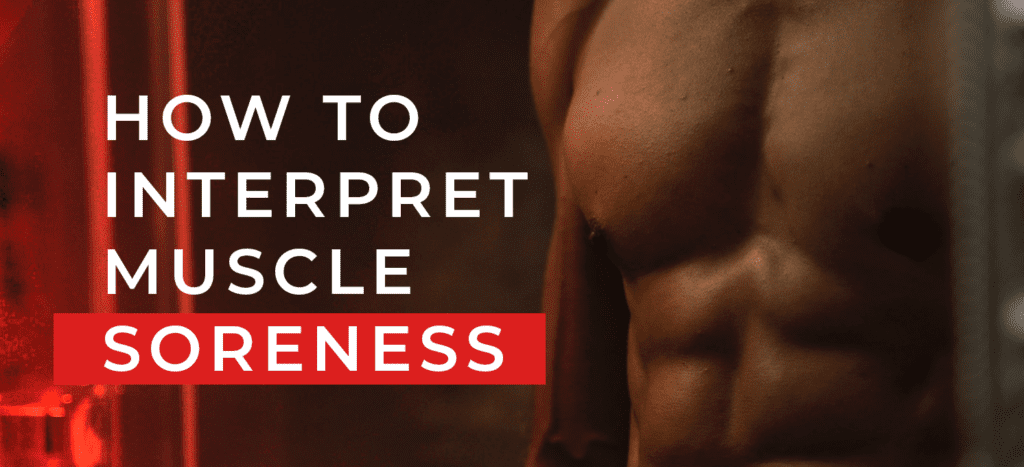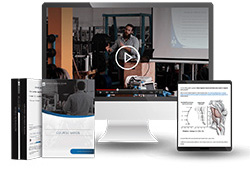How to interpret muscle soreness

Here’s what muscle soreness can and cannot tell you according to science. Delayed onset muscle soreness (DOMS) is something we’ve all experienced and intuitively, you may think it means you had a good workout or that your muscles are growing. Indeed, soreness can be associated with muscle swelling, but that’s edema, water retention in the muscle, not contractile muscle growth. Most of my subscribers are probably aware now that being sore is not necessarily a sign you had a good workout. You can get big without getting sore and getting sore doesn’t guarantee you’ll get big.
However, many people still use muscle soreness as some indicator of recovery after a workout. This is also wrong. Muscle soreness correlates poorly with muscle damage, if it correlates at all. For example, here are the data from a study that measured muscle soreness and creatine kinase elevation, a measure of muscle damage, after a heavy leg day in weightlifters vs. untrained individuals. While the untrained individuals experienced far more muscle damage, soreness levels were actually a bit higher in the weightlifters. The difference in muscle damage was thus not reflected in different levels of soreness. The time-courses of muscle damage and soreness also didn’t correspond well. The untrained individuals were no longer sore at day 6, yet their muscles were still very damaged.


Below are the data from another study that measured muscle soreness vs. strength recovery after endurance vs. maximal eccentric exercise. After the endurance exercise, strength recovered rapidly with most recovery in 24 hours and nearly full recovery at 48 hours (no longer significantly different from baseline), yet this period was when soreness peaked. The eccentric exercise caused considerably more neuromuscular fatigue and strength loss than the endurance training, yet ratings of soreness weren’t that different compared to after the endurance exercise. Other research also finds that certain types of training, such as electrically stimulated muscle contractions, can inflict significantly more muscle damage than conventional strength training without increasing DOMS.


Perhaps the best evidence of the dissociation between soreness and recovery is that training through soreness often doesn’t make it worse. Many of my clients get very sore the first time they do their new workout routines, yet repeating them a few days later while they’re still sore often reduces the soreness. At this point their performance is already slightly greater, indicating that soreness can persist after neuromuscular recovery and even supercompensation have completed.
Soreness may not even be related to muscle damage at the cellular level. There’s emerging research that muscle soreness is more closely related to our connective tissues than our contractile tissues in the muscle. Wilke & Behringer (2021) concluded: “the findings support the hypothesis that DOMS originates in the muscle-associated connective tissue rather than in the muscle itself.”
Soreness also has a significant neural component. Soreness isn’t a direct reflection of muscle or connective tissue damage, as there’s significant modulation of how much we feel a given level of damage. The repeated bout effect majorly reduces the soreness you get from any type of exercise, so you mostly get sore from novel stimuli, even if your habitual workouts are still causing damage and fatigue.
Conclusion
Muscle soreness probably does mean there is some level of damage: you can’t get sore without damage. (Phantom DOMS?) However, the magnitude of soreness doesn’t correlate with the extent of muscle damage or neuromuscular fatigue and certainly not with the extent of muscle growth. You can have high levels of muscle damage or fatigue without soreness.
So basically all a sore muscle tells you is that muscle was involved in some exercise you did earlier. Some people and some body parts get much more sore than others. You mostly get sore after novel training stimuli, such as trying new exercises or higher training volumes. Don’t worry about soreness.
 Want more content like this?
Want more content like this?
Then get our free mini-course on muscle building, fat loss and strength.
By filling in your details you consent with our privacy policy and the way we handle your personal data.
